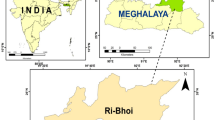Summary
Evaluation of the caving behaviour of longwall roof rocks has thus far been based on a pot-pourri of classification systems, which ignore basic caving criteria. The paper outlines a new classification model of roof strata namely cavability using fuzzy set methodology and linguistic variables to assign ratings for individual roof beds. A microcomputer program has been developed to evaluate the decision ratings for cavability and the model applied to ten longwall case-histories from Indian coalfields. The classification model has excellent potential for being used as a standard tool for the evaluation of caving behaviour of longwall roof rocks.
Similar content being viewed by others
References
Bellman, R.E. and Zadeh, L.A. (1970) Decision making in a fuzzy environment,Management Science 17 (4) B141-B164.
Bieniawski, Z.T. (1974) Geomechanics classification of rock masses and its application in tunnelling, inProceedings of the Third International Congress in Rock Mechanics, ISRM, Denever, Volume 11A, pp. 27–32.
Bieniawski, Z.T., Rafia, F. and Newman, D.A. (1980) Ground control investigations for assessment of roof conditions in coal mines, inProceedings of the 21st. US Symposium on Rock Mechanics, Rolla, MO, pp. 691–700.
Bikerman, D.J. and Mahtab, M.A. (1986) Use and abuse of RQD in underground mine design, inProceedings of Mining Latin America Conference, Santiago, Chile, Nov, IMM, London, pp. 51–56.
Deere, D.U. (1964) Technical description of rock cores for engineering purposes,Rock Mechanics and Engineering Geology 1,1 17–22.
Dubois, D. and Prade, H. (1980)Fuzzy sets and systems theory and applications, Academic Press, New York, p. 393.
Dutta, D., Bhattacharya, J., De, P., Ghosh, A.K., and Ghose, A.K. (1986) Longwall face support design—a micro-computer model,Journal of Mines, Metals and Fuel, March, 97–107.
Ghose, A.K. and Raju, N.M. (1981) Characterization of rock massvis-a-vis application of rock bolting-modelling of Indian coal mines, inProceedings of the, MIT, Boston, MA, pp. 1–6.
Karmis, M. and Kane, W. (1984) An analysis of the geomechanical factors influencing coal mine roof stability in Appalachia, inProceedings of the 2nd International Congress on Stability in Underground Mining, Lexington, pp. 311–25.
Kendorski, F.S., Cummings, R.A., Bieniawski, Z.T. and Skinner, E.H. (1983) Rock mass classification for block caving mine drift support, inProceedings of the 5th International Congress on Rock Mechanics, ISRM, Melbourne, p. 13.
Laubscher, D.H. (1977) Geomechanics classification of jointed rock masses-mining applications,Transactions Institute of Mining and Metallurgy,86 183–203.
Nguyen, V.U. (1985) Some fuzzy set applications in mining geomechanics,International Journal of Rock Mechanics Mining Sciences and Geomechanics Abstracts 6,22 369–79.
Sarkar, S.K. and Singh B. (1985)Longwall Mining in India, Mrs. Sunanda Sarkar, CMRS, Dhanbad, 237p.
Seegmiller, B.L. (1983) Geotechnical and stability requirements for future coal mines,Rock Mechanics and the Design of Structures in Rock, Willey Interscience, New York, pp.650.
Thill, R.E. (1984) Coal and rock properties for premise planning and mine design, inProceedings of USBM Mine Ground Control Technology Transfer, USBMIC 8973, pp. 15–35.
Timoshenko, S. and Woinowsky-Krieger, S. (1959)Theory of Plates and Shells, Kogakusha, Tokyo, pp.120.
Unal, E. (1983)Design guidelines and roof control standards for coal mine roofs PhD thesis, The Pennsylvania State University, 355p.
Wickham, G.E., Tiedemann, H. and Skinner, E.H. (1972) Support determinations based on geologic predictions, inProceedings of the 1st Rapid Excavation and Tunnelling Converence, Vol. 1, Chicago (edited by K.S. Lane and L.A. Garfield), AIME, New York, pp. 43–64.
Zadeh, L.A. (1965) Fuzzy sets,Information Control 8 338–353.
Zadeh, L.A. (1975) The concepts of linguistic variable and its application to approximate reasoning, Part 1, 2 and 3,Information Science 8 199–249;8, 301–357;9, 43–80.
Zadeh, L.A. (1976) A fuzzy algorithmic approach to the definition of complex and imprecise concepts,International Journal of Man Machine Study 8 249–291.
Author information
Authors and Affiliations
Rights and permissions
About this article
Cite this article
Ghose, A.K., Dutta, D. A rock mass classification model for caving roofs. International Journal of Mining and Geological Engineering 5, 257–271 (1987). https://doi.org/10.1007/BF01560777
Received:
Issue Date:
DOI: https://doi.org/10.1007/BF01560777




